Allanton Estate
THE STUARTS OF ALLANTON
Family that helped to mould History.
Battle of Morningside 600 years ago
The demolition of Allanton House removed a link with the stirring days of Scottish history. The Steuarts whose line has now died out, were one of the old-established families of Scotland. They were related to Lord Darnley the unhappy husband of Mary, Queen of Scots; and their story is rich with romantic incident,
One day in the year 1385 a troop of Scottish horsemen, with a grey haired man of over sixty at their head, were riding to join the army of their king. Seventy-one years previously the Battle of Bannockburn had freed the Scots from the yoke of their oppressors, the English. Now another English king Richard II, had dreams of conquering the northern kingdom once more, and had crossed the border with a huge army. From all over the Lowlands of Scotland barons, knights and gentlemen were hastening to unite against the "auld enemy.”
These horsemen recruited from Lanarkshire and Renfrewshire, were led by Allan Steuart of Daldowie, in Clydesdale, married to a daughter of the Black Douglas. Allan was no novice in the arts of war. He was nicknamed 'Alnwickster' because of the dash and courage he showed when in his young days he headed a party which stormed the Castle of Alnwick, in Northumberland, in a border raid. Despite his advancing years, Alan had again responded to his country's need. He was destined however, never to reach the main Scottish army. His way lay through the parish of Cambusnethan, so called, because it had been the favourite resort of the Pictish King Nethan in the 9th century. It signifies the curve of Nethan, referring to the wide sweep taken by the Clyde at this point. Where the smiling grasslands of the Clyde valley gave place to the Moor of McMorren, Allan encountered an advanced party of the English. A fierce engagement ensued, in which the Scots were victorious; but their leader was slain.
The site of this conflict is now known as Morningside, and Allan's body was buried in the nearby chapel of Bueskiag, which has given the district the name of 'the Chapel' in use to this day. Out of this encounter arose the connection of the Steuart family with Allanton.
Allan was accompanied by his son of the same name who after the burial of his father, assumed command of the troop, rode on to join the Scottish army and assisted in defeating the English. For this exploit he had conferred upon him by King Robert ll, King of Scotland, the honour of Knight Banneret being created a knight for the royal standard, the highest military honour of the time.
Afterwards Sir Allan served for many years in France, and did not return to Scotland until 1421. In that year he obtained from the Abbot of Aberbrothic, now Arbroath, feudal lord of the district, certain lands in the moor of McMorren. He called his new estate Allanton and assumed the tittle of Sir Allan Steuart, of Daldowie and Allanton,
Ancient Line
Sir Allan was one of a line which can be traced back to the eleventh century. His grandfather Sir Robert Steuart of Daldowie, was sixth of a certain Sir John Steuart of Bonkyll, so called because of his marriage to Margaret de Bonkyll. Sir John in turn was the second son of the sixth Great Steward of Scotland - a title indicating that the bearer had a high position in the Royal household, reserved for men of noble birth. This post was hereditary and the first Great Steward of Scotland, whose office gave the family its name died in 1089. The name persisted even in offshoots of the family, like the Steuarts of Allanton who no longer had any close connection with the Throne.
Scotland, when Sir Allan became Laird of Allanton, had emerged from the turbulent period of her history which began with the invasion of the Scots, and ended in the tenth century with the merging of Picts and Scots into one kingdom under Malcolm Canmore. England was the common enemy, driven out in 1314, and border skirmishes were to be daily occurrences for years to come. But Allanton was far enough from the Borders - and from the highlands - to offer some prospect of peace and security.
The place names of the new estate, closely associated as it was with a glorious incident in the family's history, perpetuated the memory of the fight in which Sir Allan's father died. Cathburn, for example means 'the battle burn’. Alcathmuir (now Aughtermuir) the name given to the whole district, means ‘the moor of Allan's battle' ; known today as Aughterwater. Allanton became Sir Allan's favourite estate, and he took up residence there.
He was succeeded on his death by his eldest son, James who was nicknamed 'of Paris' because he was born in France, where his father had married a French lady before returning to Scotland. James greatly improved the Allanton estate.
His son, another James, called 'the antiquary' on account of his interest in literature, succeeded him on his death, and is chiefly remembered for the narrative of the Steuart Family which he began, and which was continued by some of his descendants. 'The antiquary' died in 1489, and was succeeded by his second son, Allan. Allan had two sons the elder, Gavin, inherited the lands of Daldowie, and the younger Adam, the lands of Allanton.
TAILOR WITH AN APPETITE
Adam Steuart of Allanton lived during one of the most interesting stages of Scottish history. It was the time when the privileges of the Reformation were being diffused, particularly in the West, and he was an intimate acquaintance of the leading reformer, George Wishart, who suffered martyrdom at St, Andrews in 1546.
Wishart occasionally found sanctuary from his persecutors in the Tower of Allanton. There was a small secret apartment in the old tower formed out of the thickest part of the wall and here more than one refugee was hidden until the hue and cry had passed. The existence of the apartment was, it is said, kept secret even from the servants. Only one man was taken into the family's confidence - a tailor, who had an important part to play when the hiding place was occupied. He sat cross - legged in front of the concealed entrance, busy with needle from morning till night. Fortunately there were no trade unions in those days, and no one hindered him from working for as long as he pleased. He was favoured, too, in that his meals were sent to him as he worked, and what meals! Dainties from the family table, heaped on the plate so that you would have thought it impossible for any mortal man to dispose of it all. But the plates invariably came back clean, and the tailor's appetite became a standing joke in the servant's hall. They do not seem so have suspected that half of the food was for somebody they did not see.
Adam Steuart seems to have been a man of some consequence, for in 1536 he entered England, then a journey of sufficient hardship to require a safe conduct, on a mission whose nature is not recorded. He died in 1574, without issue, and the estate of Allanton devolved to James Steuart (born in 1537) the son and heir of Adam's brother Gavin Steuart of Daldowie. Thus the estates of Allanton and Daldowie were again united.
AT THE BATTLE OF LANGSIDE
James Steuart upheld the family military and religious tradition. A friend and admirer of John Knox, he was an outstanding supporter of the Reformation. It was natural therefore, that he should fight against the army of Mary, Queen of Scots, at Langside. His part in the battle was so important that he was known afterwards as James of Langside. The Queen's army had dispersed the opposing cavalry, and were proceeding to break the infantry, who were drawn up on Langside Hill. Steuart, in command of a troop of horsemen, perceived the danger, led his men in a charge, and repulsed the vanguard of the Queen's army before they reached the summit of the hill. The respite thus gained enabled the nobles to reorganise their ranks, and ultimately achieve the victory. Mary fled across the border to her English cousin, Elisabeth and entered upon the grim chapter of her stormy life, which ended some twenty years later in Fotheringay Castle.
James Steuart’s share in the defeat of the Queen brought down upon him the wrath of Lord Hamilton and Lord Seton, who declared that they would pull the house down about his ears. The threat was carried out, and James retired to Allanton to spend the remainder of his life in the peaceful development of his estate. He died in 1608; and his eldest son having predeceased him, he was succeeded by his grandson, Sir Walter Steuart, who was born in 1606.
FOUNDATION OF COLTNESS FAMILY
During Sir Walter's minority the lands of Daldowie were sold, to clear off some encumbrances. They had been in the possession of the Steuarts for over three hundred years. Under Sir Walter the family fortunes were restored. In 1653 he was able to purchase the lands of Coltness, from Halilton of Udston, for his younger brother, thus founding the important branch of the family, the Steuarts of Coltness. Sir Walter was married to the sister of the first Lord Belhaven, and had a very large family. His heir fought under General Leslie at Dunbar in 1650, when Cromwell’s Ironsides smashed the Covenanters' army. His experiences told on young Steuart's health, and brought about his death at a very early age.
When Cromwell was returning from Glasgow to Edinburgh during that campaign, he passed through Cambusnethan, and visited Allanton House. Sir Walter, prudently enough, took care not to be at home; but his wife remained to extend hospitality to the Protector. It was related that a delicate son of Sir Walter was particularly attracted by the hilt of Cromwell's sword, and as the Englishman was sitting at the table ventured closer to examine it. Cromwell patted him on the head, and called him "My little Captain". "Captain" Steuart he was called from then on; though considering the political sympathies of the family, one wonders what the others thought of the compliment.
FIRST CHURCH AT GREENHEAD
Sir Walter's life at Allanton was enlivened by a rivalry with other families in the district, particularly Sommerville of Cambusnethan. When the latter wanted to bury a child of his in the choir of the old church (on whose site the conventicles are still held annually) Steuart led the opposition to this procedure, which was contrary to the edict of the Assembly. He won his point, and went on to greater triumphs; for he led the agitation for a new church at Greenhead, and succeeded when it was built in 1650, in gaining for his family the coveted front seat of the aisle gallery. This building was later superseded by the present Cambusnethan Old Parish Church. Sir Walter died in 1672, and was succeeded by his eldest surviving son, William, who was born in 1640, and married his cousin, daughter of Sir James Steuart of Coltness. His alliance with the Coltness Steuarts caused him to suffer for their adherence to the Covenant and he was very heavily fined. In 1687 however, James II remitted the fines and, going still further, offered to create him a baronet. But William thought his hereditary title of knight banneret a greater honour, and declined the baronetcy.
After William as laird of Allanton came his son James, in 1700, and after him, in 1762, another James, who was a fine scholar and an eminent agriculturist.
"THE PLANTER’S GUIDE"
Successor to this James Steuart was Henry, born in 1759. He was quite a remarkable gentleman. In the army till 1787, he retired to Allanton to devote himself to literary pursuits and the improvement of his estate. In 1807 he published a pamphlet advocating the construction of a canal from the Lanarkshire coalfields to Edinburgh. At his death in 1838 he left in manuscript a fragment of a history of the rebellion of 1745, and notes for a history of Scotland. His magnum opus was "The Planter’s Guide", in which he described a new method or planting trees. His own estate was a witness to the soundness of his ideas; much of its beauty is due to his care. Henry's literary attainments won for him the degree of LL.D., and he was a fellow of the Royal Society, and of the Antiquarian Society of Edinburgh.
In 1787 he married Lillias, daughter or Hugh Seton, Squire of Touch, and about the same time built the present mansion house, as the old Tower of Allanton was in a state of decay. In 1814 he was created a baronet; and he died in 1836.
Sir Henry's only surviving child was his daughter, Elizabeth Margaret, who married in 1812 Reginald Macdonald, of Staffa. In 1835, on the death of her mother, she succeeded to the estate of Touch, and on the death of her father the title devolved to her husband, who assumed the name of Steuart-Seton, of Edinburgh.
LAST of THE LINE
In 1884 Sir Henry-James died, and the title and estates fell to his nephew, Sir Alan Henry Seton-Steuart. Sir Alan did not occupy Allanton House a great deal, and it is from this time that the decline of Allanton estate may be traced. On his death in 1913, without issue, he was succeeded by his brother, Sir Douglas Archibald Seton-Steuart. With the death of Sir Douglas the line died out.
Allanton estate was then divided up for sale in 1932 into small holdings and farms. The house and grounds were acquired by Coltness Iron Coy., and were leased to various tenants. A few years ago, however, it became impossible to let the house, owing to its great size. It was finally occupied by a number of families, and from then its condition rapidly deteriorated. The decision reached to have it demolished was inevitable.
With it went last evidence of the possession of the estate by a family which had a considerable say not only in the history of Cambusnethan, but even of Scotland. The magnificent woods on the estate remain a lasting monument to the Steuarts’ vision and enthusiasm, while the place names of the district still recall the exploits hundreds of years ago, of Allan Steuart whose death led to the foundation of the Allanton branch of the family.
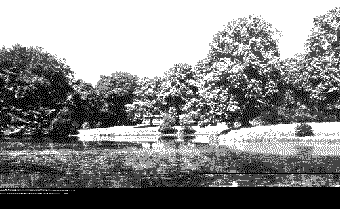 Later History of Estate
Later History of Estate
A tea-room (Woodypoint) and small caravan site were in use for some time at the North end of the lower loch.
In the 1970s the A71 bypass was built to cut out the bad bends at the Auchter bridge and those of Allanton woods, removing the through traffic in Bonkle. This effectively cut the Allanton estate in two. The lower part was later sold to Mr Hill who cleaned and partly drained the two lochs. A large dwelling house was built on the North side of the lower loch. A high security fence now surrounds the area preventing access. The access to the upper, South side of the estate along the track to Allanton is now overgrown and almost impassible even on foot. Except for the trees, little of the remains of a once glorious estate can be found.
The pictures, obtained from Norman Allan's collection, and William McCafferty, reflect bygone days.
The text was obtained from material left by Sandy McIntyre but the author is not known.
Most of it can be found in the book Historical Sketches of the Parish of Cambusnethan.
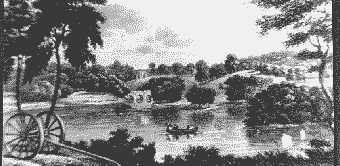
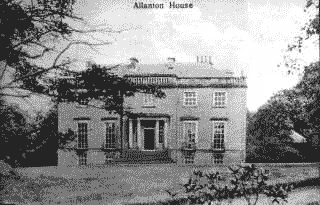
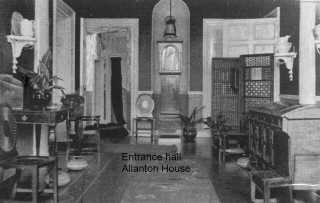
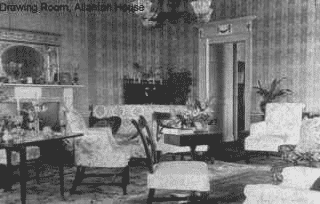
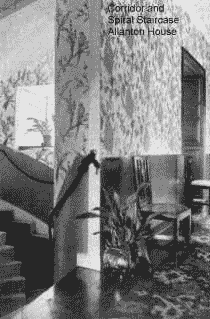
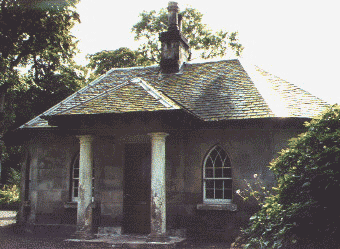
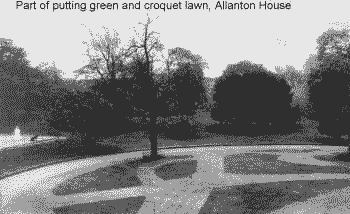
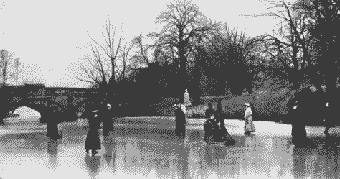
Corridor & spiral staricase
Entrance hall
Allanton House
West gatehouse looking
towards Bonkle
Skaters on upper
Allanton loch
Putting green & croquet lawn
Drawing room
Allanton Estate with house
in background